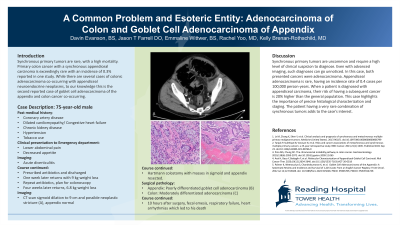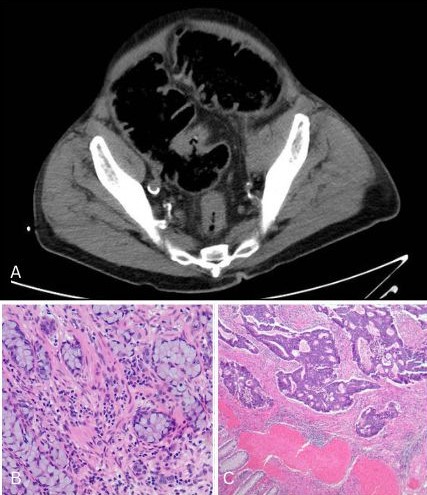Sunday Poster Session
Category: Colon
P0341 - A Common Problem and Esoteric Entity: Adenocarcinoma of Colon and Goblet Cell Adenocarcinoma of Appendix
Sunday, October 27, 2024
3:30 PM - 7:00 PM ET
Location: Exhibit Hall E

Has Audio

Davin Evanson, BS
Drexel University College of Medicine
Reading, PA
Presenting Author(s)
Davin Evanson, BS1, Jason T. Farrell, DO2, Emmaline Wittwer, BS1, Rachel Yoo, MD2, Kelly Brenan-Rothschild, MD2
1Drexel University College of Medicine, Reading, PA; 2Reading Hospital - Tower Health, Reading, PA
Introduction: Synchronous primary tumors are rare, with a high mortality. Primary colon cancer with a synchronous appendiceal carcinoma is exceedingly rare with an incidence of 0.3% reported in one study. While there are several cases of colonic adenocarcinoma co-occurring with appendiceal neuroendocrine neoplasms, to our knowledge this is the second reported case of goblet cell adenocarcinoma of the appendix and colon cancer co-occurring.
Case Description/Methods: A 75-year-old male with history of coronary artery disease, dilated cardiomyopathy and chronic systolic heart failure, chronic kidney disease, hypertension and tobacco use presented to the emergency department with lower abdominal pain and decreased appetite. Imaging showed acute diverticulitis, for which he was prescribed antibiotics and discharged. One week later he had recurrent symptoms and a 9 kg weight loss, and was given a repeat course of antibiotics, with a plan to do an outpatient colonoscopy in six weeks. Four weeks later he had recurrent symptoms and ongoing weight loss of an additional 6.8 kg. CT scan that admission showed sigmoid dilation to 9 cm and possible neoplastic stricture, with appendix read as normal. Given these findings he underwent Hartmann colostomy during which masses in the sigmoid and appendix were discovered and resected. Surgical pathology of the appendix showed a poorly differentiated goblet cell adenocarcinoma, and colon pathology showed moderately differentiated adenocarcinoma. Unfortunately, ten hours after surgery, the patient experienced fecal emesis, respiratory failure, and heart arrhythmias which led to his death.
Discussion: Synchronous primary tumors are uncommon and require a high level of clinical suspicion to diagnose. Even with advanced imaging, such diagnoses can go unnoticed. In this case, both presented cancers were adenocarcinoma. Appendiceal adenocarcinoma is rare, having an incidence rate of 0.4 cases per 100,000 person-years. When a patient is diagnosed with appendiceal carcinoma, their risk of having a subsequent cancer is 20% higher than the general population. This case highlights the importance of precise histological characterization and staging. The patient having a very rare combination of synchronous tumors adds to the case's interest.

Disclosures:
Davin Evanson, BS1, Jason T. Farrell, DO2, Emmaline Wittwer, BS1, Rachel Yoo, MD2, Kelly Brenan-Rothschild, MD2. P0341 - A Common Problem and Esoteric Entity: Adenocarcinoma of Colon and Goblet Cell Adenocarcinoma of Appendix, ACG 2024 Annual Scientific Meeting Abstracts. Philadelphia, PA: American College of Gastroenterology.
1Drexel University College of Medicine, Reading, PA; 2Reading Hospital - Tower Health, Reading, PA
Introduction: Synchronous primary tumors are rare, with a high mortality. Primary colon cancer with a synchronous appendiceal carcinoma is exceedingly rare with an incidence of 0.3% reported in one study. While there are several cases of colonic adenocarcinoma co-occurring with appendiceal neuroendocrine neoplasms, to our knowledge this is the second reported case of goblet cell adenocarcinoma of the appendix and colon cancer co-occurring.
Case Description/Methods: A 75-year-old male with history of coronary artery disease, dilated cardiomyopathy and chronic systolic heart failure, chronic kidney disease, hypertension and tobacco use presented to the emergency department with lower abdominal pain and decreased appetite. Imaging showed acute diverticulitis, for which he was prescribed antibiotics and discharged. One week later he had recurrent symptoms and a 9 kg weight loss, and was given a repeat course of antibiotics, with a plan to do an outpatient colonoscopy in six weeks. Four weeks later he had recurrent symptoms and ongoing weight loss of an additional 6.8 kg. CT scan that admission showed sigmoid dilation to 9 cm and possible neoplastic stricture, with appendix read as normal. Given these findings he underwent Hartmann colostomy during which masses in the sigmoid and appendix were discovered and resected. Surgical pathology of the appendix showed a poorly differentiated goblet cell adenocarcinoma, and colon pathology showed moderately differentiated adenocarcinoma. Unfortunately, ten hours after surgery, the patient experienced fecal emesis, respiratory failure, and heart arrhythmias which led to his death.
Discussion: Synchronous primary tumors are uncommon and require a high level of clinical suspicion to diagnose. Even with advanced imaging, such diagnoses can go unnoticed. In this case, both presented cancers were adenocarcinoma. Appendiceal adenocarcinoma is rare, having an incidence rate of 0.4 cases per 100,000 person-years. When a patient is diagnosed with appendiceal carcinoma, their risk of having a subsequent cancer is 20% higher than the general population. This case highlights the importance of precise histological characterization and staging. The patient having a very rare combination of synchronous tumors adds to the case's interest.

Figure: A-CT Abdomen showing colonic dilation up to 9 cm with thickening in distal sigmoid concerning for neoplastic stricture. B-Pathology image: Goblet cell adenocarcinoma of appendix. C-Pathology image: Colon adenocarcinoma
Disclosures:
Davin Evanson indicated no relevant financial relationships.
Jason Farrell indicated no relevant financial relationships.
Emmaline Wittwer indicated no relevant financial relationships.
Rachel Yoo indicated no relevant financial relationships.
Kelly Brenan-Rothschild indicated no relevant financial relationships.
Davin Evanson, BS1, Jason T. Farrell, DO2, Emmaline Wittwer, BS1, Rachel Yoo, MD2, Kelly Brenan-Rothschild, MD2. P0341 - A Common Problem and Esoteric Entity: Adenocarcinoma of Colon and Goblet Cell Adenocarcinoma of Appendix, ACG 2024 Annual Scientific Meeting Abstracts. Philadelphia, PA: American College of Gastroenterology.

